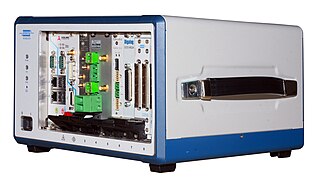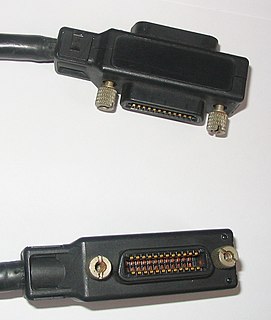
Data acquisition is the process of sampling signals that measure real world physical conditions and converting the resulting samples into digital numeric values that can be manipulated by a computer. Data acquisition systems, abbreviated by the acronyms DAS or DAQ, typically convert analog waveforms into digital values for processing. The components of data acquisition systems include:

Electronic test equipment is used to create signals and capture responses from electronic devices under test (DUTs). In this way, the proper operation of the DUT can be proven or faults in the device can be traced. Use of electronic test equipment is essential to any serious work on electronics systems.
LAN eXtensions for Instrumentation (LXI) is a standard developed by the LXI Consortium, a consortium that maintains the LXI specification and promotes the LXI Standard. The LXI standard defines the communication protocols for instrumentation and data acquisition systems using Ethernet. Ethernet is a ubiquitous communication standard providing a versatile interface, the LXI standard describes how to use the Ethernet standards for test and measurement applications in a way that promotes simple interoperability between instruments. The LXI Consortium ensures LXI compliant instrumentation developed by various vendors work together with no communication or setup issues. The LXI Consortium ensures that the LXI standard complements other test and measurement control systems, such as GPIB and PXI systems.

A frequency counter is an electronic instrument, or component of one, that is used for measuring frequency. Frequency counters usually measure the number of cycles of oscillation, or pulses per second in a periodic electronic signal. Such an instrument is sometimes referred to as a cymometer, particularly one of Chinese manufacture.
The VXI bus architecture is an open standard platform for automated test based upon VMEbus. VXI stands for VME eXtensions for Instrumentation, defining additional bus lines for timing and triggering as well as mechanical requirements and standard protocols for configuration, message-based communication, multi-chassis extension, and other features. In 2004, the 2eVME extension was added to the VXI bus specification, giving it a maximum data rate of 160 MB/s.

Automatic test equipment or automated test equipment (ATE) is any apparatus that performs tests on a device, known as the device under test (DUT), equipment under test (EUT) or unit under test (UUT), using automation to quickly perform measurements and evaluate the test results. An ATE can be a simple computer-controlled digital multimeter, or a complicated system containing dozens of complex test instruments capable of automatically testing and diagnosing faults in sophisticated electronic packaged parts or on wafer testing, including system on chips and integrated circuits.
Keysight VEE is a graphical dataflow programming software development environment from Keysight Technologies for automated test, measurement, data analysis and reporting. VEE originally stood for Visual Engineering Environment and developed by HP designated as HP VEE; it has since been officially renamed to Keysight VEE. Keysight VEE has been widely used in various industries, serving the entire stage of a product lifecycle, from design, validation to manufacturing. It is optimized in instrument control and automation with test and measurement devices such as data acquisition instruments like digital voltmeters and oscilloscopes, and source devices like signal generators and programmable power supplies.

PCI eXtensions for Instrumentation (PXI) is one of several modular electronic instrumentation platforms in current use. These platforms are used as a basis for building electronic test equipment, automation systems, and modular laboratory instruments. PXI is based on industry-standard computer buses and permits flexibility in building equipment. Often modules are fitted with custom software to manage the system.

The Standard Commands for Programmable Instruments defines a standard for syntax and commands to use in controlling programmable test and measurement devices, such as automatic test equipment and electronic test equipment.

UniPro is a high-speed interface technology for interconnecting integrated circuits in mobile and mobile-influenced electronics. The various versions of the UniPro protocol are created within the MIPI Alliance, an organization that defines specifications targeting mobile and mobile-influenced applications.
M-Modules are a mezzanine standard mainly used in industrial computers. Being mezzanines, they are always plugged on a carrier PCB that supports this format. The modules communicate with their carrier over a dedicated bus, and can have all kinds of special functions.
NI Measurement Studio is a set of test and measurement components built by National Instruments, that integrates into the Microsoft Visual Studio environment. It includes extensive support for accessing instrumentation hardware. It has drivers and abstraction layers for many different types of instruments and buses are included or are available for inclusion.
BNC 575 is electronic test equipment by Berkeley Nucleonics Corporation. It is the 2007/2008 version of a series of benchtop digital delay generator/pulse generator that began with the BNC 400 and BNC 500 in 2000. This version improves upon the earlier designs with better resolution (250ps), more channels and more functionality Channel-to-channel and external trigger jitter have both been significantly improved from earlier designs. The BNC 575 replaces the BNC 565 and BNC 555. New capabilities include int/ext clock for synchronizing and pulse picking, summing timing of several channels onto one, independent trigger and gate and selectable timing reference for each channel.
AdvancedTCA Extensions for Instrumentation and Test (AXIe) is a modular instrumentation standard created by Aeroflex, Agilent Technologies, and Test Evolution Corporation. (In October 2008, Aeroflex had purchased a 40% shareholding in Test Evolution.)
eXtensible Host Controller Interface (xHCI) is a computer interface specification that defines a register-level description of a host controller for Universal Serial Bus (USB), which is capable of interfacing with USB 1.x, 2.0, and 3.x compatible devices. The specification is also referred to as the USB 3.0 host controller specification.
Bustec is a company that designs and manufactures instrumentation for high-performance data acquisition and instrument control. The company's products serve applications that include engine testing, automotive and missile testing, wind tunnel data acquisition and control, acoustics, vibration applications, aircraft component testing and more. Headquarters is located in Shannon, Co. Clare, Ireland.
HiSLIP is a TCP/IP-based protocol for remote instrument control of LAN-based test and measurement instruments. It was specified by the IVI Foundation and is intended to replace the older VXI-11 protocol. Like VXI-11, HiSLIP is normally used via a library that implements the VISA API. Version 1.4 of the LAN eXtensions for Instrumentation (LXI) standard recommends HiSLIP as “LXI HiSLIP Extended Function for LXI based instrumentation”.









